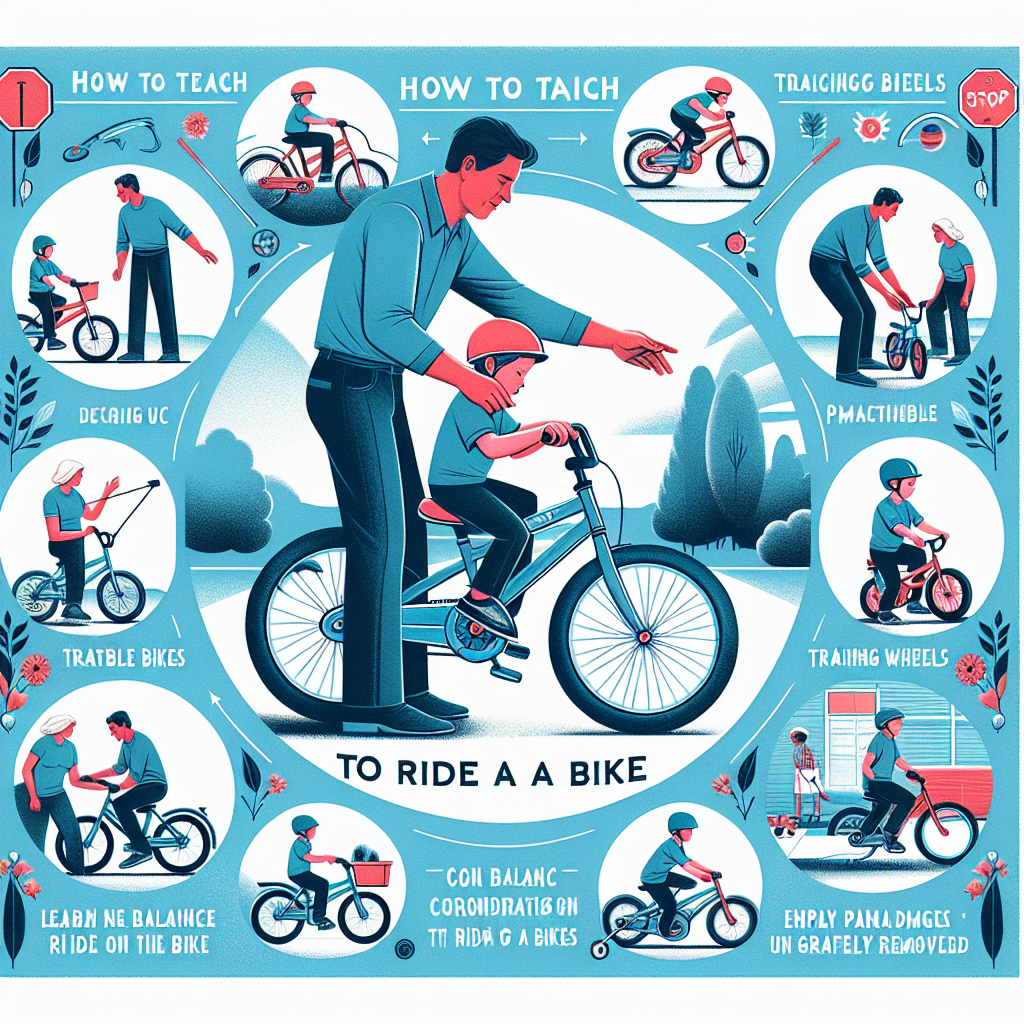So you’ve got a little one who’s ready to take on the big world of bike riding? It’s an exciting milestone, but where do you start? Teaching a child to ride a bike doesn’t have to be a daunting task. With a little patience, encouragement, and the right techniques, you can have them pedaling with confidence in no time. In this article, we’ll explore some tried and true methods to help you guide your child towards becoming a skilled bike rider. From finding the right bike to mastering balance, we’ve got you covered. So grab your helmet and let’s get rolling! Disclosure: As an Amazon Associate, I earn from qualifying purchases.
Choosing the Right Bike
When it comes to teaching a child how to ride a bike, one of the first steps is to choose the right bike for their age and size. Size and fit are crucial in ensuring a comfortable and safe riding experience for your child. You want to make sure that the bike is not too big or too small, as this can affect their ability to control the bike and maintain balance.
To determine the right bike size for your child, consider their height and inseam measurement. Most bike manufacturers provide size charts that correlate with these measurements, making it easier to select the appropriate bike size. It’s important to remember that children grow quickly, so finding a bike with an adjustable seat height and handlebars can allow for growth and extended use.
In addition to size, another factor to consider when choosing a bike is the brakes and gears. For beginners, it’s generally recommended to start with a bike that has coaster brakes (brakes that engage when the pedals are pushed backward) instead of hand brakes. This allows the child to focus on learning to pedal and balance without the added complexity of using hand brakes.
Similarly, gears are not typically necessary for beginner riders. It’s important to keep the bike as simple as possible in the beginning, allowing the child to focus on developing their fundamental biking skills. As their confidence and proficiency grow, you can consider introducing bikes with more gears and advanced features.
Lastly, you may also need to decide between training wheels or a balance bike. Training wheels offer stability and support while the child is learning to balance and pedal, but they can become a crutch and hinder the development of balance and coordination. On the other hand, balance bikes have no pedals and allow children to focus solely on balance and steering. This can help them gain confidence and improve their ability to ride a bike without the aid of training wheels. Ultimately, the choice between training wheels and a balance bike depends on the individual child and their learning style.
Preparing for the First Lesson
Before diving into the first bike riding lesson, it’s essential to ensure that your child has the necessary safety equipment. Safety should always be a priority when it comes to biking, and this includes wearing a well-fitted helmet. Make sure the helmet is worn properly, with the straps securely fastened and the helmet sitting level on the head. You may also want to consider elbow and knee pads for added protection, especially if your child is just starting out.
Choosing the right location for the first lesson is also crucial. Look for a quiet and spacious area, such as an empty parking lot or a nearby park with a wide, paved path. Avoid areas with heavy traffic or rough terrain that may be challenging for your child to navigate. An open space with minimal obstacles will allow your child to focus on their bike handling skills without distractions.
Before beginning the lesson, take the time to adjust the bike to ensure a comfortable and safe fit for your child. Check that the seat height is appropriate, allowing for a slight bend in the knee when the foot is placed on the pedal at its lowest position. Adjust the handlebars so that they are within easy reach and at a comfortable angle for your child’s arms. These adjustments will help promote proper body positioning and reduce strain while riding.

Getting Started: Lesson One
Lesson One is all about introducing your child to the bike and getting them comfortable with the basics of balancing and scooting. Start by giving them a brief introduction to the different parts of the bike, such as the pedals, handlebars, and brakes. Teaching them how to use the brakes effectively is essential for safety, so make sure they understand how to engage the brakes and come to a controlled stop.
Next, encourage your child to practice scooting and balancing on the bike without using the pedals. This will help them get a feel for the bike’s balance and how it responds to their movements. Let them scoot around using their feet to push off the ground while keeping their feet off the pedals. This activity helps build muscle memory and coordination, laying the foundation for pedaling later on.
Using feet as training wheels is another useful technique to help your child develop a sense of balance and control. This involves having your child lift their feet off the ground while riding and trying to maintain their balance. Initially, they can start by lifting one foot and then gradually progress to both feet. It’s important to emphasize the importance of keeping their eyes forward and focusing on a fixed point for better balance.
Lesson Two: Pedaling and Coasting
Once your child has gained confidence in balancing and scooting, it’s time to introduce them to pedaling. Teach them the basic pedaling technique by demonstrating how to push the pedals with the balls of their feet. Encourage them to start pedaling slowly and gradually increase their speed as they become more comfortable. Remind them to keep their feet level and to pedal in a smooth and circular motion.
As they get the hang of pedaling, introduce them to coasting. This involves lifting their feet off the pedals and letting the bike roll. Coasting helps children understand the concept of momentum and balance while not relying on pedaling. Encourage them to coast for short distances at first and gradually increase the distance as their confidence grows.
During Lesson Two, it’s important to focus on providing positive reinforcement and encouragement to boost your child’s confidence. Celebrate their accomplishments, no matter how small, and continuously remind them of their progress. Building confidence is key to helping them overcome any fears or hesitations they may have about riding a bike.

Lesson Three: Steering and Turning
In Lesson Three, your child will learn how to steer and make controlled turns. Proper hand positioning is essential for efficient steering, so teach your child to hold the handlebars firmly with both hands. Their thumbs should be wrapped around the handlebars, while their fingers securely grip the grips.
Start by practicing simple steering maneuvers, such as gently turning the bike to the left and right. Encourage your child to use their body weight to lean into the turns and maintain balance. As they become more comfortable with basic steering, progress to more controlled turns by using their hands and arms to steer instead of relying solely on body weight.
Common mistakes to watch out for during Lesson Three include oversteering or jerky movements. These can lead to instability and loss of control. Remind your child to steer gently and smoothly, making gradual and deliberate movements.
Building Stamina and Confidence
As your child progresses through the bike riding lessons, it’s important to incorporate progressive challenges to build their stamina and confidence. This involves gradually increasing the duration and intensity of their rides. Start with short rides around the neighborhood and gradually extend the distance as they become more comfortable and proficient.
Encouraging independent riding is another crucial step in building confidence. Allow your child opportunities to practice riding on their own, away from your constant supervision. However, always ensure they are in a safe and controlled environment. Giving them the space to explore and master their bike-riding skills independently will boost their confidence and demonstrate their progress.
Skills development should also progress gradually. Introduce new skills and techniques in a systematic and progressive manner, building upon their existing knowledge and abilities. Continuously challenge and motivate your child to reach new milestones, reinforcing their belief in their abilities as a cyclist.

Transitioning to Solo Riding
Removing training wheels is a significant milestone in a child’s biking journey. The transition to riding without training wheels can be a bit daunting, but with the right approach, it can be a smooth progression. Start by adjusting the bike so it only has one pedal remaining and lower the seat for easier balance. This will allow your child to practice balancing without the need to pedal.
Spotting and guiding your child during this transition is crucial. Run alongside them while holding onto the back of the seat or their shoulders, providing support and stability. Slowly release your grip as they gain confidence and find their balance. Be patient during this process, as it may take several attempts before your child starts pedaling on their own without any assistance.
Patience and support are key during this period of adjustment. Your child may experience frustration or setbacks, and it’s essential to provide positive reinforcement and reassurance. Remind them of their progress and celebrate their achievements, no matter how small. With your continued support, they will gradually gain the skills and confidence needed to ride solo.
Dealing with Frustrations and Setbacks
Learning to ride a bike can be both exciting and challenging for a child. It’s important to address any frustrations or setbacks they may encounter throughout the process. Positive reinforcement is a powerful tool in motivating your child and helping them overcome any fears or anxieties they may have.
Praise their efforts and offer words of encouragement when they face challenges. Focus on their progress rather than any mistakes they make. Remind them that making mistakes is a normal part of the learning process and that everyone learns at their own pace.
Address any fear or anxiety your child may have by discussing their concerns openly and honestly. Reassure them that you will always be there to support and guide them during their bike riding journey. Encourage them to take breaks or step back if they feel overwhelmed, allowing them time to reset and regain their confidence.

Safety Tips for Riding
Safety should always be a top priority when teaching a child to ride a bike. While you may have already covered wearing a helmet as part of the safety equipment, there are additional safety tips to keep in mind.
Ensure your child understands the importance of wearing a helmet every time they ride. Model this behavior yourself by wearing a helmet whenever you ride as well. Teach them about the importance of staying visible to others on the road by wearing brightly colored clothing and using reflectors or lights on their bike.
Instruct your child on the importance of following traffic rules and using hand signals when turning. Teach them to look both ways before crossing roads or intersections and to be aware of their surroundings at all times. Encourage them to practice riding in a straight line and to avoid sudden stops or swerves that could lead to accidents.
Conclusion
Learning to ride a bike is a milestone in every child’s life, and it’s a journey that should be celebrated and enjoyed together. By choosing the right bike, preparing for the first lesson, and gradually progressing through the lessons, you can help your child develop the skills and confidence needed to ride independently.
Remember to be patient and supportive, and to acknowledge and celebrate their achievements along the way. Continue riding together, exploring new places, and enjoying the freedom and joy that biking brings. With your guidance and support, your child will become a confident and skilled cyclist.
Disclosure: As an Amazon Associate, I earn from qualifying purchases.

